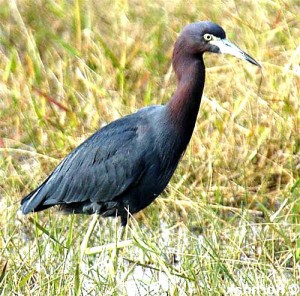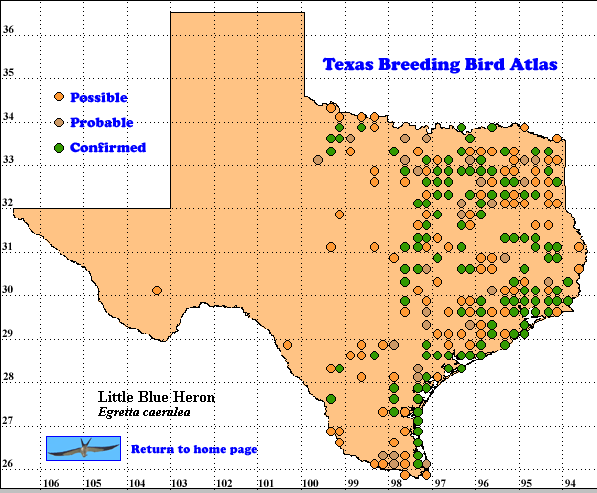Because of its dark slate-blue plumage and lack of long ornate breeding plumage, Little Blue Herons were not directly decimated during the era of plume hunting. However, since they nest in association with plume-bearing species, disturbance to heronries must have had some adverse effect upon them locally until they received legal protection and the benefit of conservation and management efforts.
Because of their dark color and secretive and solitary habits, Little Blue Herons are often overlooked. As true of other colonial waterbirds, their breeding success is subject to adverse weather and predation; but food limitation is the most significant factor regulating their populations. They rarely raise a full brood of chicks (Rodgers and Smith 1995).
In Texas, an important influence on waterbird populations is the 20-25 year precipitation cycle (Telfair 2002). Between the early 1960s and the late 1980s, there was a significant upward trend in the cycle; since then, the trend has begun to decrease (Tom Spencer, Texas Forest Service, pers. comm.). The trend varies regionally and there are intermittent drought years and irregular intervals with pronounced wet/dry springs-summers such as those associated with El Niño/La Niña years and massive slow-moving atmospheric disturbances. Inland wetland habitats are particularly subject to the effects of these trends. Unfortunately, there is a lack of data about the status of the Little Blue Heron in Texas before the 1970s; so, the possible relationship between its breeding populations and the precipitation cycle is unknown for earlier years.
Breeding colonies of Little Blue Herons are difficult to accurately census because their dark plumage blends with the closely-spaced foliage within which they nest. Therefore, there is need for more reliable ground-based censuses.
DISTRIBUTION: The Little Blue Heron inhabits fresh water and salt water marshes, swamps, tidal flats, coastal lagoons, rivers, streams, oxbow lakes, and human-made habitats, e.g., canals, ditches, flooded rice fields and pastures, and aquaculture ponds (Kushlan and Hancock 2005).
Most breeding of Little Blue Herons occurs inland east of the 98th meridian with scattered breeding in north central and south Texas east of the 100th meridian. Some nesting occurs coastally, primarily on the upper and central coasts (TBBA). Based upon Texas colonial waterbird censuses (1973-1990), most of the breeding population is inland (87-99%) with a few years in which 17-21% nest coastally. There is a single record of nesting in Kerr County in the east Edwards Plateau region (Oberholser 1974).
Inland breeding distribution and timing of the breeding season of the Little Blue Heron is probably determined in Texas by the availability of crayfish which compose about 73% of the diet of the chicks (Telfair 1981). The greatest abundance of adults and the growth stages of the three species of crayfish used as major food items occurs during the time of breeding and corresponds to the average period of maximum spring rains. Thus, the greatest biomass of available crayfish occurs during the period of hatching and chick growth. During years when rainfall is abundant in spring and early summer, an abundance of crayfish and other aquatic prey items are available in flood plain pools, ponds, oxbow lakes, swamps, marshes, roadside ditches, and borrow pits.
SEASONAL OCCURRENCE: Breeding occurs from early March to late July; eggs late March – June 16; nestlings mid April – July 29 (Oberholser 1974, Telfair 1983). In summer, Little Blue Herons are common residents in the eastern third of Texas and along the Coastal Prairies to the Lower Rio Grande Valley. They are rare to locally uncommon postbreeding wanderers in the western two-thirds of the state; in winter, small numbers may be present along the Coastal Prairies, rarely inland east and south of the Edwards Plateau to north central and northeast Texas (Lockwood and Freeman 2004).
BREEDING HABITAT: Most Little Blue Herons nest in upland woods and motts with closed canopies, riparian tree sites, swamps, and wooded inland and coastal islands (Telfair 1993). They may nest in small single-species colonies or in large multi-species colonies. Nests are placed from 0.5-12 m(1.5-40 ft) high in shrubs and trees (Kushlan and Hancock 2005) and may be placed side-by-side with other species or mostly with conspecifics (Rodgers and Smith 1995). Some large multi-species colonies are reestablished annually for as many as 30+ years, but others are not. The reasons for this difference are unknown. Some of the large colonies are considered nuisances when they are located near human habitation (Telfair et al. 2000).
STATUS: According to Texas colonial waterbird censuses from 1972-1990, the breeding population of the Little Blue Heron fluctuated between 3,985 and 22,146 pairs (Telfair 1993). Analysis of the trend data showed the breeding population had an annual decreasing trend of -2.2%.However, there were four years of incomplete censuses (1977, 1978, 1980, and 1985); thus, the downward trend is biased. Also, between 1972-1990, and especially between 1982-1990, there was a gradual decrease in the number of large colonies of Little Blue Herons (Telfair 1993). Unfortunately, comprehensive inland annual breeding censuses have not been conducted since 1990. However, coastal data between 1973-2000 were analyzed by McFarlane (2002). He found an annual increasing trend of +2.8%. So, if there has been a decline inland, it may be related to regional responses to the precipitation cycle (see Introduction and Distribution discussions above). North American Breeding Bird Survey data for Texas (Sauer et al. 2005) give annual trends of -4.2% (1966-1979), -5.0% (1980-2005), and -3.4% (1966-2005); thus, supporting the statewide decreasing trend indicated by colonial waterbird census data.
Text by Raymond C. Telfair II (2007)
Literature cited:
Kushlan, J. A. and J. A. Hancock. 2005. The herons. Oxford Univ. Press Inc., New York.
Lockwood, M. W. and B. Freeman. 2004. The TOS handbook of Texas birds. Texas A&M. University Press, College Station.
McFarlane, R. W. 2002. Texas colonial waterbird trends (Powerpoint presentation). http://www.fws.gov/texascoastalprogram/TCWC.htm.
Oberholser, H. C. 1974. The bird life of Texas. University of Texas Press, Austin.
Rodgers, J. A., Jr. and H. T. Smith. 1995. Little Blue Heron (Egretta caerulea). In The Birds of North America, No. 145 (A. Poole and F. Gill, eds.) The Birds of North America, Inc., Philadelphia PA.
Sauer, J. R., J. E. Hines, and J. Fallon. 2005. The North American breeding bird survey, results/analysis 1966-2005. Version 6.2.2006. USGS Patuxent Wildl. Res. Cnt., Laurel, Maryland. http://www.mbr-pwr.usgs.gov/bbs/bbs.html.
Telfair , R. C. II. 1981. Cattle Egrets, inland heronries, and the availability of crayfish. Southwest. Nat. 26: 37-41.
Telfair, R. C. II. 1983. The Cattle Egret: a Texas focus and world view. Kleberg Stud. Nat. Resour. Tex. Agric. Exp. Stn., Texas A&M Univ., College Station.
Telfair, R. C. II. 1993. Cattle Egret (Bubulcus ibis) population trends and dynamics in Texas (1954-1990). Nongame and Urban Program, Fish. and Wildl. Div., Texas Parks and Wildl. Dept. PWD-RP-N-7100-234, Austin.
Telfair, R. C. II. 2002. Inland heronries in Texas. Texas Partners in Flight Newsletter, Texas Parks and Wildl. Dept. 9: 20.
Telfair, R. C. II, B. C. Thompson, and L. Tschirhart. 2000. Nuisance heronries in Texas: characteristics and management. 2nd ed. Wildl. Diversity Prog. , Wildl. Div., Texas Parks and Wildl. Dept. PWD BK W7000-134 (1/00).

